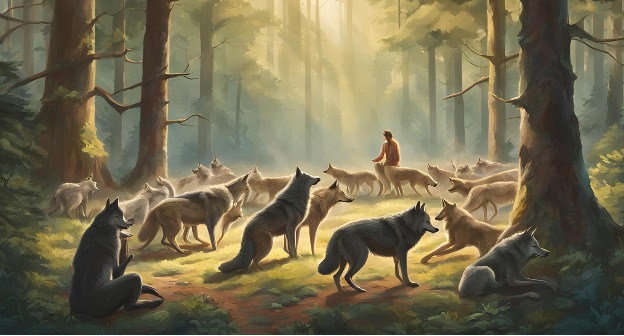As urbanization accelerates globally, human-wildlife interactions are becoming more frequent, leading to significant conflicts. These confrontations manifest in various forms, such as wildlife-vehicle collisions, zoonotic disease transmission, and property damage. Urban growth puts pressure on wildlife populations, creating a need for effective management strategies. Deterrence, relocation, and other measures impose selective pressures on wildlife, yet the evolutionary dynamics of how these species adapt to urban settings remain underexplored. Understanding these interactions is crucial to promoting coexistence, and Shaun Ellis’ unique experience living with wolves offers valuable insights into the relationship between humans and wildlife.
Shaun Ellis: From Fear to Fascination
Shaun Ellis grew up with an innate fear of wolves, shaped by myths and stories that portrayed them as dangerous. However, seeing one at a zoo sparked a fascination that would eventually shape his life. In his 20s, inspired by the work of American naturalist Levi Holt, who ran a wolf research center in Idaho, Ellis sold his possessions and traveled to the U.S. to join the team. He started as a field biologist, tracking wolves and collecting data, but his desire to understand them on a deeper level pushed him further. He wondered if it was possible for a human to integrate into a wolf pack and gain unique insights into their behavior and social structure.
Living with Wolves: The Journey Begins
After a year of working with the biologists, Ellis took a bold step—he moved into the wilderness to live among a wolf pack. His first close encounter, just 30 meters away, transformed his fear into respect. Gradually, a wolf pack began to trust him, allowing him to live alongside them. He shared their diet, eating raw deer and elk, and spent his days observing their behavior, especially with the younger wolves. He became a part of their world, not as a hunter but as a guardian of the pups, offering protection and contributing to the pack’s safety.
The Challenges of Life Among Wolves
Living with wolves brought Ellis closer to nature, but it also introduced him to the dangers of living in the wild. Once, Ellis made the mistake of eating the wrong part of a kill, which led to a wolf clamping its jaws around his face—a harsh reminder of the pack’s strict hierarchy. On another occasion, a wolf saved him from walking into the path of a bear, protecting him and the pack’s pups from the threat. Despite these dangers, Ellis felt a strong sense of belonging among the wolves.
Return to Society: Sharing the Lessons
After more than a year, Ellis’ body was worn down from the harsh conditions, and he made the difficult decision to leave. Returning to society was a shock, but the knowledge he gained was invaluable. Today, Ellis runs a wolf center in Devon, where he educates others about wolves, emphasizing their role in ecosystems and the importance of coexistence. His experience living with wolves highlights how these animals, far from being ruthless, are family-oriented creatures that deserve respect.
Broader Challenges: Human-Wildlife Interactions in Urban Environments
Ellis’ unique experience underscores the broader challenges of human-wildlife interactions in an increasingly urbanized world. As cities expand, encounters with wildlife rise, leading to conflicts. A key consideration in managing these conflicts is understanding whether behavioral changes in wildlife are due to plasticity (flexible behavior) or genetic adaptation. For example, if traits like boldness are plastic, non-lethal deterrents can encourage cautious behavior. However, if these behaviors are genetically rooted, more invasive measures like targeted removals may be necessary.
Urban Planning and Wildlife: Strategies for Coexistence
Urban planners must account for how wildlife responds to development. Studies of leopards in Pakistan and wild boars in Hong Kong highlight the need for proactive designs, such as wildlife corridors and green infrastructure, to reduce conflict. Initiatives like the successful conservation of otters in Singapore demonstrate the potential for urban greening to create safe habitats for wildlife while improving public perceptions.
Collaboration for Coexistence
Addressing the challenges of human-wildlife coexistence requires collaboration between evolutionary biologists, urban planners, conservationists, and local stakeholders. In regions like Asia and Africa, where urbanization is rapidly transforming landscapes, engaging local communities in the planning process ensures that conservation strategies are tailored to specific historical and ecological contexts. Participatory research enhances decision-making and fosters coexistence by incorporating local perspectives.
Conclusion: A Question for the Future
In conclusion, the lessons learned from Shaun Ellis’ time living with wolves and the broader challenges of increasing human-wildlife interactions demonstrate that coexistence is possible, but it requires thoughtful planning and mutual respect. By understanding wildlife behavior, adapting urban designs, and fostering collaboration across various fields, we can create environments where both humans and animals thrive. As cities continue to grow, we are left with a simple yet meaningful question: Can humans and wildlife truly live together in peace?
Image Credit:
AI-Image Generated
Sources:
Schell, C. J., Stanton, L. A., Young, J. K., Angeloni, L. M., Lambert, J. E., Breck, S. W., & Murray, M. H. (2020, September 29). The evolutionary consequences of human-wildlife conflict in cities. Evolutionary applications. https://www.ncbi.nlm.nih.gov/pmc/articles/PMC7819564/
Wierucka, K., Hatten, C. E., Murphy, D., Allcock, J. A., Andersson, A. A., Bojan, J. W., Kong, T. C., Kwok, J. K., Lam, J. Y., H, C., MA, Phalke, S., Tilley, H. B., Wang, R. S., Wang, Y., Webster, S. J., Mumby, H. S., & Dingle, C. (2023). Human-wildlife interactions in urban Asia. Global Ecology and Conservation, 46, e02596. https://doi.org/10.1016/j.gecco.2023.e02596
Reporter, G. S. (2021, October 30). Experience: I lived with wolves. The Guardian. https://www.theguardian.com/lifeandstyle/2011/jan/15/i-lived-with-wolves



